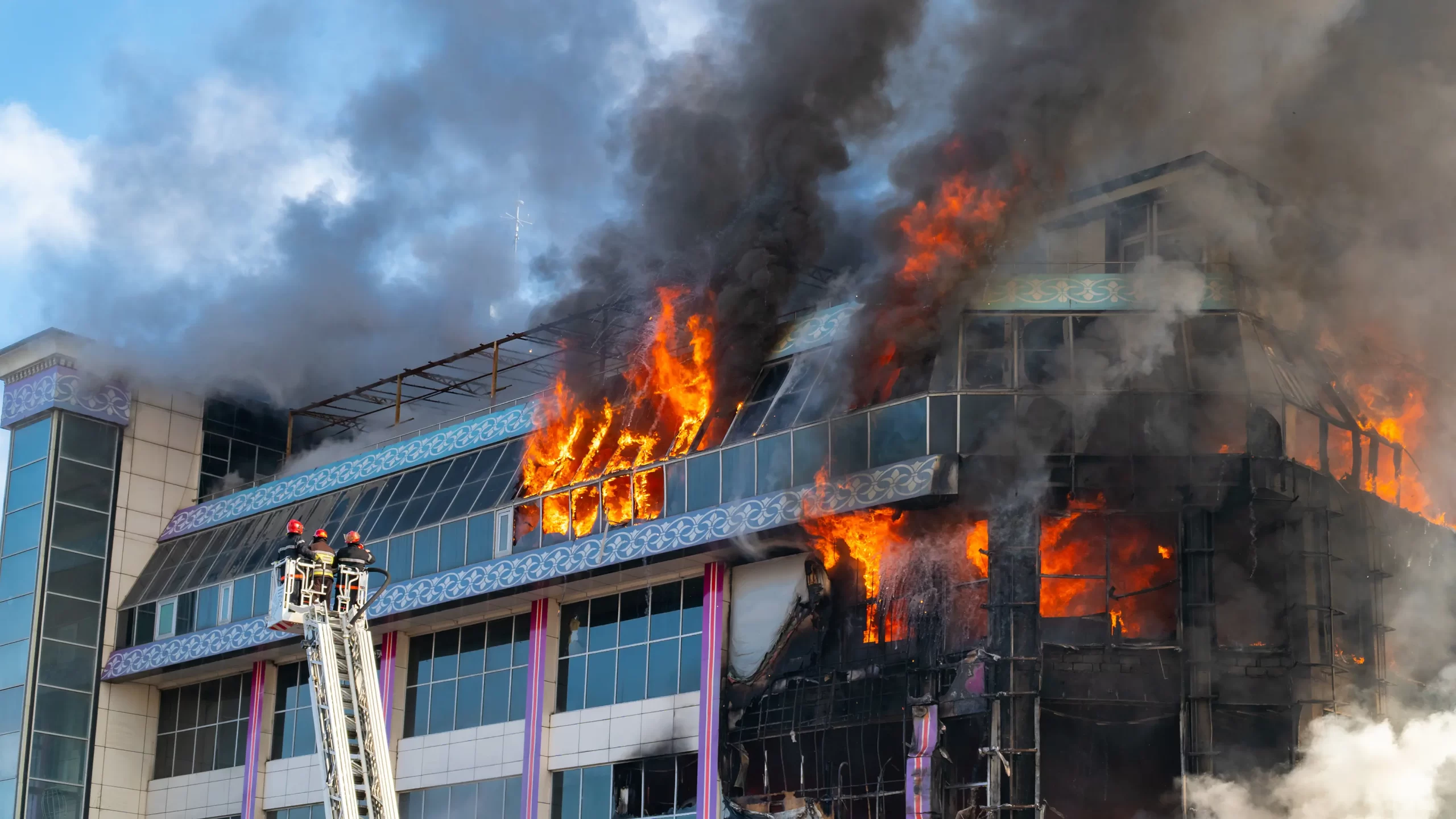Why Your Business Needs a Fire Risk Assessment Now

In today’s rapidly evolving business climate, safeguarding assets against unforeseen disasters is paramount, particularly emphasising the pivotal role of a business fire risk assessment . This crucial evaluation supports fire prevention and forms the backbone of a company’s emergency plan, assuring personnel safety and property preservation. A well-conducted fire risk assessment identifies potential fire hazards, evaluates the effectiveness of existing fire control measures, and proposes enhancements where necessary. Underpinning this is a legal requirement that mandates the responsible person within an organisation to undertake regular assessments to minimise the risks associated with fire, thereby ensuring a safer working environment for all.
The forthcoming segments of this article will delve into the legal imperatives for conducting a fire risk assessment, underscore its significance in mitigating financial loss and guaranteeing business continuity, and outline the fundamental steps to carry out a thorough assessment. Additionally, guidance will be provided on choosing the right fire risk assessor, a competent person who can navigate the complexities of fire safety legislation, identify potential escape routes, and implement a comprehensive emergency plan. Through an in-depth exploration of these areas, businesses will be equipped with the knowledge to uphold safety standards and fulfil their legal obligations, underscoring the indispensability of a fire risk assessment in today’s corporate landscape.
Legal Imperatives for Fire Risk Assessment
Understanding the Law
The Regulatory Reform (Fire Safety) Order 2005 and the Fire Safety (England) Regulations 2022 have set a comprehensive legal framework that mandates rigorous adherence to fire safety measures. The designated Responsible Person is legally required to ensure that all occupants within their premises are safe, which involves conducting regular fire risk assessments and implementing necessary safety protocols. This legal framework consolidates over 70 pieces of previous legislation, simplifying the requirements into a more manageable and enforceable set of rules that focus heavily on prevention and the responsibilities of the ‘responsible person’.
Consequences of Non-Compliance
Non-compliance with fire safety regulations can result in severe penalties, including substantial fines and, in some cases, imprisonment. Fines can range from minor charges up to £5,000 for less severe breaches to unlimited fines for more serious offences. More severe breaches may also lead to up to 2 years in prison. Beyond financial penalties, non-compliance can also lead to civil liabilities where affected parties such as employees, customers, or neighbouring businesses may seek compensation.
Moreover, the consequences of failing to comply extend beyond legal repercussions; they can lead to significant loss of life and property. This underscores the importance of adhering to the regulations to avoid penalties and actively ensuring the safety and well-being of all individuals on the premises. Businesses must remain vigilant and informed about the latest fire safety laws, understanding that compliance is not just a legal obligation but a moral one, critical to safeguarding lives and business continuity.
In non-compliance cases, specific defences and an appeal process are available, which are crucial for those facing potential legal action. However, the emphasis should always be on proactive compliance to prevent fire incidents and the associated legal and financial consequences.
Mitigating Financial Loss and Ensuring Business Continuity
In the event of a fire, the repercussions can be severe, impacting not only the physical assets but also the financial stability and operational continuity of a business. A comprehensive fire risk assessment is pivotal in identifying potential fire hazards and implementing preventive measures to safeguard against significant financial repercussions and ensure business continuity.
Case Studies of Financial Ruin
The financial impact of a fire can be devastating. Businesses often face extensive property damage, including destroying buildings, equipment, and inventory, which can run into millions. The immediate financial losses are just the tip of the iceberg. When a business is forced to cease operations temporarily, it loses vital income, which can be particularly detrimental for small businesses with limited cash reserves. Moreover, the costs associated with rebuilding and restoring operations, such as compliance with safety codes and installation of new fire prevention systems, add to the financial strain.
Additionally, a fire incident can lead to losing customers who may turn to competitors, and the effort to regain their trust can be costly and time-consuming. Legal and regulatory challenges that often follow a fire incident, including insurance claims and potential lawsuits from injured parties, further compound the financial burdens faced by businesses.
Insurance Benefits
Insurance plays a critical role in mitigating financial losses following a fire. Regular fire risk assessments can significantly influence the terms and premiums of insurance policies. Businesses can benefit from lower insurance premiums and more favourable terms by demonstrating a commitment to fire safety and risk mitigation. Furthermore, a well-documented fire risk assessment facilitates the claims process, potentially speeding up settlements and reducing the financial impact of a fire.
However, businesses must comply with all policy terms and take reasonable precautions to minimise fire risks. Failure to adhere to these requirements can lead to denied claims, leaving the business to bear financial losses. Ensuring that fire risk assessments are up-to-date and all identified risks are addressed can prevent such scenarios, safeguarding the business’s financial health and operational stability 7.
By prioritising fire risk assessments and adhering to legal and insurance requirements, businesses can protect themselves from the dire financial consequences of fire incidents and ensure their long-term viability and success.
Steps to Conduct a Fire Risk Assessment
Identify Fire Hazards
The initial phase in conducting a fire risk assessment involves identifying potential sources of fire within the workplace. Key sources include cigarettes, matches, lighters, candles, cooking equipment, and any gas or liquid-fuelled equipment that might ignite. Electrical, gas, or oil-fired heaters and any hot processes or surfaces should be scrutinised for potential risks. Observing signs of potential hazards, such as scorch marks or charred plugs, is crucial in identifying areas at risk of igniting a fire.
Evaluate Risks and Mitigation Steps
Once hazards are identified, the next step is to evaluate the risks associated with these hazards and to implement measures to reduce or eliminate the risks. This involves assessing the potential sources of fire like wood, paper, cloth, flammable liquids, gases, and electrical equipment. The assessment should also consider the effectiveness of safety measures such as evacuation plans, fire extinguishers, water sprinklers, and smoke detection systems. Evaluating these aspects helps ensure that the safety measures are effective and comply with current regulations.
Documentation and Review
The final step involves documenting all the findings from the fire risk assessment and planning for regular reviews. This documentation serves as a record of all identified hazards, assessed risks, and safety measures implemented. It is essential for maintaining compliance with fire safety regulations and for making necessary amendments to fire safety procedures when changes occur, such as the introduction of new equipment, changes in building layout, or updates in fire safety regulations. Regular fire risk assessment reviews ensure that the measures remain effective and that the business is prepared to respond to fire-related emergencies.
By following these steps, businesses can significantly enhance their fire safety management, ensuring the safety of all occupants and minimising the risk of fire-related incidents.
Choosing the Right Fire Risk Assessor
Criteria for Competence
Selecting a suitable fire risk assessor is crucial for ensuring compliance with the Regulatory Reform (Fire Safety) Order 2005, which mandates a suitable and sufficient fire risk assessment for all non-domestic premises in England and Wales. Although not expected to be an expert in fire safety, the Responsible Person must exercise due diligence when appointing a consultant to undertake this task. It is essential that the chosen consultant demonstrates sufficient competency.
A competent fire risk assessor should possess a blend of training, experience, and knowledge appropriate for assessing the premises’ complexity. For simpler, low-risk environments, assessors need a good grasp of current fire safety practices and an awareness of their own limitations, seeking external help when necessary. In contrast, more complex premises require assessors with higher qualifications and proven expertise, often demonstrated through professional memberships or third-party certifications.
Benefits of Professional Assessors
Employing a professional fire risk assessor brings numerous advantages. Firstly, they ensure that the fire risk assessment complies with legal standards, reducing the Responsible Person’s liability in case of fire incidents. Professional assessors are equipped to identify all potential fire hazards and evaluate the effectiveness of existing fire control measures, recommending improvements where necessary.
Moreover, a qualified assessor contributes to the overall safety and well-being of the workplace. They help businesses develop comprehensive fire safety plans tailored to specific needs, which prevent fires and prepare staff for efficient evacuation during emergencies. This proactive approach safeguards lives and property and enhances the business’s reputation by demonstrating a commitment to safety.
Additionally, a professional assessor’s involvement can influence insurance premiums favourably. Insurers often recognise the thoroughness of professionally conducted fire risk assessments, potentially offering better terms and facilitating smoother claims processes in the event of fire damage.
In conclusion, choosing the right fire risk assessor is a critical decision that impacts a business’s compliance, safety, and financial well-being. It is advisable for businesses to carefully verify the credentials and experience of potential assessors, ensuring they meet the high standards required for effective fire risk management.
Conclusion
Throughout this article, we have explored the undeniable importance of fire risk assessments in safeguarding businesses against the devastating impacts of fire incidents. From the outset, it was elucidated how these assessments are not only a legal obligation but a crucial step in protecting human lives and business assets. By highlighting the multifaceted benefits ranging from compliance with fire safety laws to mitigation of financial losses and ensuring business continuity, the role of a comprehensive fire risk assessment has been firmly established as indispensable in the modern business landscape.
In embracing the necessary steps to conduct a thorough fire risk assessment, businesses are urged to recognise the essential nature of selecting a competent fire risk assessor. This is a pivotal decision that can significantly influence a company’s fire safety strategy, ensuring both legal compliance and the protection of all stakeholders involved. The emphasis placed on the consequences of non-compliance and the array of benefits derived from diligent fire safety practices underscores the imperative for businesses to adopt and maintain rigorous fire risk assessments as a core component of their operational policies, ensuring a safer and more secure environment for all.
FAQs
Why is a fire risk assessment necessary?
A fire risk assessment is a systematic review of your workplace and work activities to identify what could potentially cause harm from a fire. It assesses the likelihood of a fire starting and evaluates the risks it would pose to those using the premises.
Is a fire risk assessment compulsory for all businesses?
Yes, if you are responsible for any building that is not a single private dwelling (a private residence), such as if you’re an employer, owner, or occupier of the premises, it is mandatory to ensure that a fire risk assessment is carried out by someone who is suitably competent.
What is the purpose of risk assessments in businesses?
The primary goal of conducting risk assessments is to identify and evaluate health and safety hazards within the workplace. It also helps in assessing the effectiveness and appropriateness of the existing measures in place to control these risks.
What makes fire risk management crucial?
Fire risk management is vital because it ensures the safety and protection of life and property. It involves identifying and implementing measures to protect employees, customers, and visitors, enhancing their safety in case a fire breaks out.


0 Comments